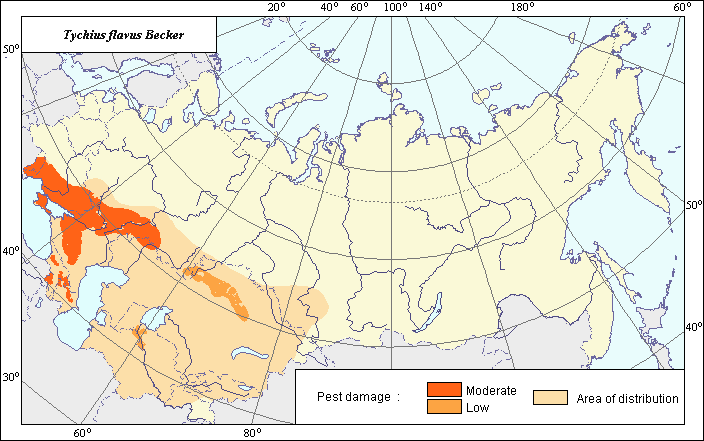Pests
Area of distribution and damage of Tychius flavus Becker.
 Object description Download GIS-layers
Object description Download GIS-layers
Authors:
Object specialist G.E. David'yan, GIS-specialist M.I. Saulich.Date of creation:
22.01.2004.Scale:
1:20 000 000.Accuracy of map:
Map was created based on materials of map(s) with scale 1:40 000 000 and on the basis of information taken from literature and by the analysis of the collections of the Zoological Institute, Russian Academy of Sciences.Projection:
.Alber.s Equal Conica for the USSR., 9, 1001, 7, 100, 0, 44, 68, 0, 0.Basic contents:
Vector map. Area of species distribution is shown by polygons. Zones of recorded mass outbreak are shown by polygons.Accuracy of classifier:
Within the area of distribution the two zones of damage (moderate and low) are established according to the extent of damaged agricultural plants. In the zone of moderate damage there is more than 18-21 adults per 100 sweeps of the butterfly net. In the zone of low damage, there is less than 18-21 adults per 100 sweeps of the butterfly net.Method of map production:
Scientists were given maps with boundaries of Oblasts and arable lands. After reviewing historic literature, species distribution was hand drawn on maps. If data were on the Oblast-level, distribution is on the Oblast level. In some cases, Oblast.s are further refined by boundaries of the Arable Land Map (Koroljeva et al., 2003). Hand drawn maps were scanned, georeferenced and vectorized. The distribution area is determined according to an analysis of the collection of the Zoological Institute (Russian Academy of Sciences) and Brobrinksii et al. (1965). The different borders of the zone of pest damage were determined according to the following publications: Ponomarenko (1934), Ivanova (1958), Makhova (1986). The zone of moderate damage is comprised of the cropping zone of lucerne in Ukraine, Moldavia, Central-Chernozem region, and in the Caucasus and Lower Volga Basin region. The zone of low pest damage is comprised of the northern part of Kazakhstan and Qoraqalpoghiston. In other areas the species has no economic significance.Reference citations:
Bobrinskii N.A., Kuznetsov B.A., Kuzyakin A.P. 1965. Keys to Mammals of the USSR. Kuzyakin A.P., editor. Moscow: Prosveshchenie. 382 p. (In Russian)Insect Collection of the Zoological Institute of Russian Academy of Sciences [ZIN RAS], St. Petersburg, Russia.
Ivanova R.V. 1958. Biological peculiarities of the Lucerne Seed Weevil (Tychius flavus Beck.) and system of its control. PhD Thesis. Leningrad-Pushkin: VIZR. 18 p. (In Russian)
Koroljeva IE, Vilchevskaya EV, Ruhovich DI. 2003. Digital Arable Land Map. Laboratory of Soil Information of the Dokuchaev Soil Institute, Moscow, Russia [Based on: Yanvareva LF. (ed.), Martynjuk KN., Kisileva NM. 1989. Map of Land Use, Faculty of Geography, Moscow State University, Moscow, Russia.].
Makhova F.A. 1986. Lucerne Seed Weevil. Zashchita rastenii, Moscow, 5: 59. (In Russian)
Ponomarenko D.A. 1934. Alfalfa seed-destroyers (Tychius flavus Beck. et Tychius femoralis Bris.) and their control in Trans-Volga. Sotsialisticheskoe zernovoe khozyaistvo, 2: 38-57. (In Russian)

